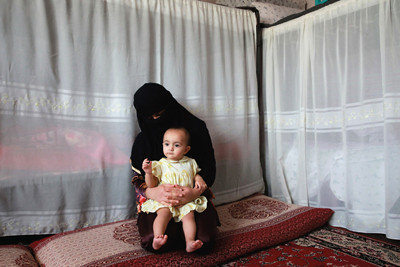By Chelsea Matiash
Five years ago, photographer Gabriela Maj met Fareshte, an inmate of Badam Bagh women’s prison, while on assignment in Afghanistan. At the time, Fareshte had been incarcerated and was awaiting two sentences related to so-called moral crimes.
She told Ms. Maj she had been raped by a man in her village, and became pregnant. The elders decided she should be stoned to death, but her father intervened with a letter to the police. She was arrested and incarcerated at Badam Bagh, where she shared a cell with several other women and her son, who was born in prison.
“I will always remember Fareshte’s story because it was the first one I heard on my very first visit to Badam Bagh,” Ms. Maj said in interview. “It also speaks to a common thread in every incarcerated woman’s story, one in which victims of abuse are transformed into criminals via the distorted lens of the Afghan justice system. It is also a story that speaks to larger societal issues in which a lack of gender equality denies woman their basic human rights.”
Fareshte’s story was the first of many the Polish-Canadian photographer would hear in her travels over the next four years spent documenting women’s prisons in Afghanistan. Many of the women Ms. Maj encountered were imprisoned for moral and domestic crimes. Their alleged offenses ranged from being sold into prostitution to fleeing from forced marriages.
The series of untitled, intimate portraits and vignettes have been woven into a monograph, titled “Almond Garden,” available in June (Daylight Books, $45). The portraits and the stories about the women are deliberately separated, and pseudonyms are used to protect the women’s privacy. By presenting the stories and images in this manner, Ms. Maj gave the women a voice—while not identifying them by their accused crimes. The title is the English translation of Bagdam Bagh, the first prison the photographer visited.
Ms. Maj’s extraordinary access didn’t come easily. While working in open prison environments, the photographer said she faced “crowding, extreme heat, violence and aggressive guards.” Once she worked with subjects, it was difficult to stay in touch, or to find them after release. Challenges aside, Ms. Maj said she found an advantage as a solitary female photographer, in that she was often left alone with her subjects. In her essay in the book, Ms. Maj writes:
“My sense was that unaccompanied by any security, a woman, albeit a foreign one, was not considered a threat…being overlooked in this way became a strategy that ultimately exposed the context within which I was working, one where women’s narratives were considered irrelevant to the power dynamics that ran the country.”
Five years later, the project serves as both a testimony and a call to action.
“My hope is that ‘Almond Garden’ serves as a record which honors the individuals portrayed in this book and an advocacy tool for change,” Ms. Maj said.




